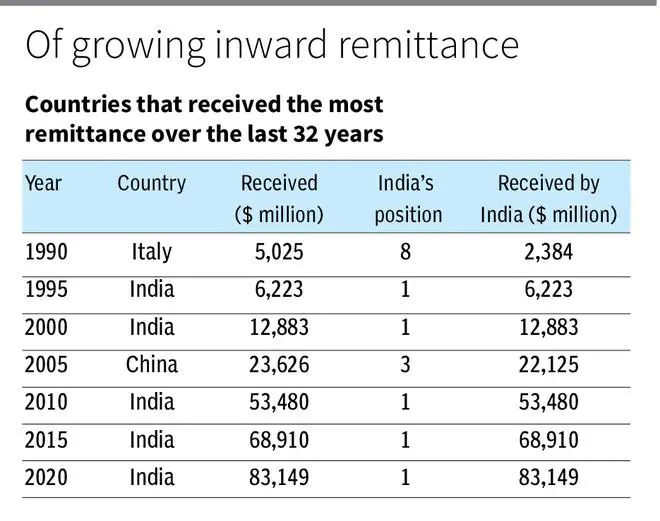The World Bank recently estimated that remittance flows to India will reach $100 billion by year end , making it the first country to ever reach the milestone.
However, this shouldn’t be surprising, suggests data. Remittances are financial or in-kind transfers made by migrants directly to families or communities in their countries of origin.
A businessline analysis of World Bank’s data shows that between 1995 and 2021, India has been receiving the highest remittances across the world for 23 years. The only years where it did not clinch the first position were 1998, 2004, 2005 and 2007.
32 years of history
In 1990, Italy received the highest inward remittance of $5,025 million. At that time, India held the eighth position globally, receiving just $2,384 million.

However, five years later, it managed to top the list with a total remittance of $6,223 million, which is 7.5 per cent of the entire internal remittance worldwide. The flows increased to $12,883 million in 2000, $22,125 million in 2005, $53,480 million in 2010, $68,910 million in 2015 and $83,149 million in 2020.
Whopper in 2021
In fact, in 2020, when remittance flows to India were 0.22 per cent lesser than what it received in 2019, it still topped the list for maximum remittance worldwide. In 2021, remisttance touched a whopping $89,375 million.

The rise in remittance to India can be largely attributed to the ever-increasing migrant population and change in migration patterns since the late 1990s. According to the World Migration Database, around that time, more Indians started moving to the USA, United Arab Emirates and Saudi Arabia. As of 2020, India-UAE is the world’s third-largest international migration country-to-country corridor, after the Mexico-US and the Syria-Turkey corridor.
Cause of rise
According to a policy brief authored by lawyer Muzaffar A Chisti for the think tank migration policy institute, a few reasons for the rise in remittance since 1990 include liberalisation, devaluation of the rupee and an increase in transfers through official channels. “The Indian government has demonstrated its ability to attract NRI capital through NRI deposit accounts and successive bond issues. The challenge is to channel some of these flows for socioeconomic development,” the brief further says.

“Remittance flows to India were enhanced by wage hikes and a strong labour market in United States and other OECD countries. In Gulf Cooperation Council countries, governments ensured low inflation through direct support measures that protected migrants’ ability to remit,” notes World Bank’s latest migration and development brief. At the same time, it also notes, “Despite reaching a historic milestone at $100 billion and retaining its position as top recipient of remittances globally, India’s remittance flows are expected to account for only 3 percent of its GDP in 2022.”
Countries apart from India that are expected to have high inward remittance flow in 2022 are Mexico ($60,300 million), China ($51,000 million), Philippines ($38,000 million) and Egypt ($32,337 million).







Comments
Comments have to be in English, and in full sentences. They cannot be abusive or personal. Please abide by our community guidelines for posting your comments.
We have migrated to a new commenting platform. If you are already a registered user of TheHindu Businessline and logged in, you may continue to engage with our articles. If you do not have an account please register and login to post comments. Users can access their older comments by logging into their accounts on Vuukle.